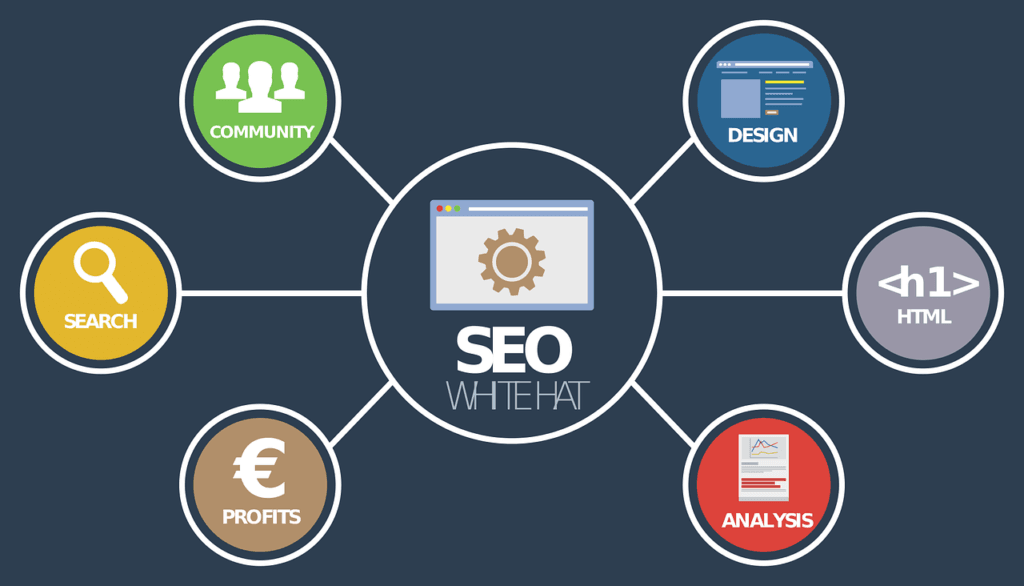This Article has been revised, edited and added to, by Poulomi Chakraborty.
- Understanding Geofencing: The Basics
- Setting Up a Geofencing Campaign
- Integrating Geofencing with Local SEO
- Crafting Effective Geofencing Campaigns for Local SEO
- Leveraging Geofencing for Competitive Advantage
- Measuring and Analyzing the Success of Geofencing Campaigns
- Conclusion
In the rapidly evolving digital marketing landscape, businesses are constantly seeking new ways to attract local customers. One emerging strategy that holds significant promise is geofencing. Geofencing involves creating a virtual boundary around a specific geographical area, enabling businesses to deliver targeted advertisements and notifications to potential customers within that zone. When combined with local SEO tactics, geofencing can create a powerful tool for enhancing local visibility and driving in-store traffic. This article explores the untapped potential of geofencing in local SEO, providing detailed insights and actionable strategies to leverage this technology effectively.
Understanding Geofencing: The Basics

Geofencing is a location-based marketing strategy that uses GPS, RFID, Wi-Fi, or cellular data to create a virtual boundary around a defined geographical area. When a mobile device enters or exits this boundary, it triggers an action, such as sending a targeted advertisement or notification.
This allows businesses to engage with potential customers who are in close proximity to their physical location, offering them relevant promotions or information in real-time.
Comparison: Geofencing vs. Traditional Local SEO
To understand the impact of geofencing, it’s helpful to compare it with traditional local SEO. Traditional local SEO focuses on optimizing your online presence to appear in local search results.
This involves using local keywords, managing online reviews, and ensuring consistent NAP (name, address, phone number) citations across various platforms. While these strategies are essential for improving local visibility, they primarily target users who are actively searching for related services.
Geofencing, on the other hand, allows businesses to proactively reach potential customers based on their physical location. This means you can engage with individuals who may not be actively searching for your services but are nearby and might be interested in what you offer.
For example, a local café could use geofencing to send a discount coupon to people walking by, enticing them to stop in for a coffee.
The Advantages of Geofencing
Geofencing offers several advantages that can complement and enhance traditional local SEO efforts. First, it provides a highly targeted marketing approach. By focusing on a specific geographical area, businesses can ensure that their marketing messages reach individuals who are most likely to visit their location. This level of precision can lead to higher conversion rates and more efficient use of marketing resources.
Second, geofencing enables real-time engagement. Traditional local SEO relies on users performing searches and finding your business among the results. Geofencing, however, allows you to initiate contact with potential customers at the exact moment they are near your location. This immediacy can be particularly effective in driving foot traffic and encouraging impulse visits.
Third, geofencing can enhance the personalization of your marketing efforts. By analyzing the behavior and preferences of individuals within your geofenced area, you can tailor your messages to better meet their needs.
For instance, if data shows that a significant number of people in your geofence are interested in health and wellness, a gym could send personalized promotions related to fitness classes or membership discounts.
Key Components of Geofencing for Local SEO
Several key components make up an effective geofencing strategy for local SEO. These include defining your geofence, creating compelling content, and monitoring and analyzing results.
Defining Your Geofence
The first step in implementing geofencing is to define the geographical area you want to target. This should be based on factors such as the location of your business, the behavior of your target audience, and the density of potential customers in the area.
The size of your geofence can vary depending on your goals; it could be as small as a single block or as large as an entire city.
Creating Compelling Content
Once you have defined your geofence, the next step is to create content that will engage potential customers within that area. This could include promotional offers, event invitations, or informative notifications about your services. The content should be relevant and enticing, encouraging individuals to visit your location or take a specific action.
Monitoring and Analyzing Results
Finally, it’s essential to monitor and analyze the results of your geofencing campaigns. Use analytics tools to track metrics such as engagement rates, foot traffic, and conversion rates. This data can provide valuable insights into the effectiveness of your geofencing efforts and help you refine your strategy over time.
Comparison: Geofencing vs. Geotargeting
It’s also important to distinguish between geofencing and geotargeting, as they are often used interchangeably but have different applications. Geotargeting involves delivering content to users based on their location, but it does not necessarily require a predefined boundary like geofencing. Geotargeting can be broader, targeting users based on city, state, or country-level data.
Geofencing, by contrast, is more precise, focusing on a specific area and triggering actions based on real-time location data. While geotargeting is useful for broader marketing campaigns, geofencing is ideal for businesses looking to drive immediate, local engagement.
Setting Up a Geofencing Campaign

Setting up a geofencing campaign requires a clear understanding of your goals, the tools you will use, and the strategies to engage your target audience effectively. Here’s a step-by-step guide to help you launch a successful geofencing campaign for your local business.
Identifying Your Goals
The first step in setting up a geofencing campaign is to identify your goals. What do you hope to achieve with geofencing? Your objectives could include increasing foot traffic to your store, promoting a special event, or driving sales through targeted promotions. Clearly defined goals will guide your campaign strategy and help you measure its success.
For example, a retail store might aim to increase in-store visits during a seasonal sale, while a restaurant might focus on attracting nearby customers during lunch hours with special discounts.
Choosing the Right Tools
Choosing the right tools is crucial for the success of your geofencing campaign. Several platforms and technologies can help you implement geofencing, including:
- Advertising Platforms: Google Ads, Facebook Ads, and other digital advertising platforms offer geofencing capabilities. These platforms allow you to create targeted ads that are triggered when users enter your geofenced area.
- Geofencing Software: Dedicated geofencing software like GroundTruth, Simpli.fi, and Radar provides advanced features for creating and managing geofencing campaigns. These tools offer detailed analytics and integration with other marketing platforms.
- Mobile Apps: If you have a mobile app for your business, you can integrate geofencing capabilities directly into the app. This allows you to send push notifications to users when they enter your geofenced area.
Choosing the right tool depends on your specific needs, budget, and technical capabilities. For small businesses, starting with geofencing features available on popular advertising platforms can be a cost-effective approach.
Defining Your Geofence
Defining your geofence involves selecting the geographical area you want to target. This area should be strategically chosen based on your business location, the behavior of your target audience, and the density of potential customers.
For example, a local coffee shop might create a geofence around nearby office buildings and public transportation hubs to attract commuters and office workers. A larger retail store might define a geofence that includes major shopping districts and popular local attractions.
Crafting Your Message
Once your geofence is defined, the next step is to craft your message. The content of your message should be relevant, engaging, and aligned with your campaign goals. Consider what will motivate your target audience to take action, whether it’s a special discount, a time-sensitive promotion, or an invitation to an event.
For example, a restaurant could send a push notification offering a 20% discount on lunch for nearby office workers. A retail store might promote a flash sale to shoppers in the vicinity, highlighting limited-time offers on popular items.
Delivering the Message
Delivering your message at the right time is crucial for the effectiveness of your geofencing campaign. Real-time delivery ensures that your message reaches potential customers when they are near your location and most likely to take action. Use the scheduling features available on your chosen platform to control when your messages are sent.
For example, a bakery might send a notification about fresh pastries in the morning when people are commuting to work. A gym could promote a free class during peak evening hours when people are finishing their workday.
Monitoring and Analyzing Results
Monitoring and analyzing the results of your geofencing campaign is essential for understanding its effectiveness and making necessary adjustments. Use analytics tools provided by your geofencing platform to track key metrics such as engagement rates, foot traffic, and conversion rates.
For example, track how many people responded to your geofenced ads and visited your store. Analyze which messages had the highest engagement and which times of day were most effective. Use this data to refine your future geofencing campaigns and improve your overall marketing strategy.
Integrating Geofencing with Local SEO

Integrating geofencing with local SEO strategies can amplify your marketing efforts and provide a more comprehensive approach to attracting local customers. By combining these techniques, you can enhance your visibility in local search results while also engaging nearby potential customers in real-time.
Optimizing Your Google My Business Profile
Your Google My Business (GMB) profile is a cornerstone of local SEO. Ensuring that your GMB profile is complete and optimized can improve your local search rankings and provide valuable information to potential customers.
Start by verifying your business, ensuring that your name, address, and phone number (NAP) are accurate and consistent with other online listings.
Add high-quality photos, detailed descriptions of your services, and regular updates to keep your profile fresh and engaging. Encourage satisfied customers to leave positive reviews, and respond to all reviews to show that you value customer feedback.
A well-optimized GMB profile increases your chances of appearing in local search results and complements your geofencing efforts by driving more traffic to your physical location.
Creating Local Content
Creating content that targets local keywords and addresses local issues can significantly boost your local SEO. This could include blog posts, articles, and videos that highlight local events, news, or issues relevant to your business.
For instance, a local gym could write blog posts about upcoming fitness events in the area, while a restaurant might create videos featuring local food festivals or farmer’s markets.
Incorporate local keywords naturally into your content to improve your chances of ranking for local searches. Keywords such as “best gym in [city]” or “top restaurants near [landmark]” can help attract local search traffic.
This content not only boosts your SEO but also provides valuable information that can engage local audiences and encourage them to visit your business.
Using Geofencing to Promote Local Content
Once you’ve created local content, use geofencing to promote it to nearby potential customers. For example, if you’ve written a blog post about a local event, you could use geofencing to send a notification to people attending the event, inviting them to read your post for more information.
This strategy can help drive traffic to your website and increase engagement with your content. It also reinforces your presence as a local business that is actively involved in the community. By combining geofencing with local content promotion, you can create a more cohesive and effective marketing strategy.
Leveraging Social Media for Local Engagement
Social media platforms offer additional opportunities to integrate geofencing with local SEO. Platforms like Facebook and Instagram allow you to create location-based ads that target users within a specific geographical area. Use these ads to promote local events, special offers, or new content that you’ve created.
Engage with local audiences by sharing updates about your business, highlighting customer testimonials, and participating in local conversations. Use location tags and hashtags to increase the visibility of your posts among local users.
By actively engaging with your local community on social media, you can build stronger relationships with potential customers and drive more traffic to your business.
Monitoring and Adjusting Your Strategy
As with any marketing strategy, it’s important to monitor the effectiveness of your geofencing and local SEO efforts and make adjustments as needed. Use analytics tools to track key metrics such as website traffic, engagement rates, and foot traffic to your store. Pay attention to which strategies are driving the most results and refine your approach based on this data.
For example, if you notice that certain types of local content are generating more engagement, focus on creating more of that content. If specific geofencing campaigns are driving more foot traffic, consider expanding those efforts to other areas. Regularly reviewing and adjusting your strategy ensures that your marketing efforts remain effective and aligned with your business goals.

Crafting Effective Geofencing Campaigns for Local SEO
Crafting effective geofencing campaigns requires a blend of creativity, strategic planning, and data analysis. To maximize the impact of your geofencing efforts, you need to understand your audience, tailor your messages, and continually refine your approach based on performance metrics.
Understanding Your Target Audience
The success of any geofencing campaign hinges on a deep understanding of your target audience. This involves not only demographic information but also behavioral insights.
Knowing when and where your potential customers are likely to be can help you define more effective geofencing boundaries and tailor your messages accordingly.
For instance, if you own a local café, you might target office workers during their morning commute and lunch breaks. Similarly, a retail store could focus on weekends when people are more likely to be shopping.
Analyzing data from past customer interactions, website analytics, and market research can provide valuable insights into your audience’s habits and preferences.
Creating Compelling Offers and Messages
Once you have a clear understanding of your target audience, the next step is to create compelling offers and messages that will entice them to visit your location. Your messages should be relevant, timely, and offer clear value.
For example, a restaurant could send a lunchtime discount coupon to nearby office workers, or a clothing store might promote an exclusive sale to shoppers in a nearby mall. The key is to offer something that will catch the attention of your audience and prompt them to take action.
When crafting your messages, keep them short and to the point. Use engaging language and include a clear call to action. For instance, “Get 20% off your lunch today! Show this message at checkout.”
Personalization can also enhance the effectiveness of your messages. If your geofencing platform allows, include the recipient’s name or reference their past purchases to make the message more relevant.
Timing Your Campaigns
The timing of your geofencing campaigns is crucial for maximizing their impact. Real-time delivery ensures that your messages reach potential customers when they are near your location and most likely to take action. Use the scheduling features available on your geofencing platform to control when your messages are sent.
Consider the typical daily routines of your target audience. For example, a gym might promote a morning workout class to early risers, while a happy hour special could be promoted to office workers heading home in the evening. By aligning your campaign timing with your audience’s habits, you can increase the likelihood of engagement and conversions.
Analyzing and Optimizing Campaign Performance
Analyzing the performance of your geofencing campaigns is essential for understanding what works and making necessary adjustments. Use analytics tools provided by your geofencing platform to track key metrics such as engagement rates, foot traffic, and conversion rates.
For example, if a particular message about a lunchtime discount had a high engagement rate, you might consider extending that offer or trying similar promotions. Conversely, if a campaign did not perform as expected, analyze the data to identify potential issues. Was the message clear? Was the offer compelling? Was the timing appropriate?
Regularly reviewing and analyzing your campaign data allows you to refine your strategy and improve the effectiveness of your geofencing efforts. This iterative approach ensures that your campaigns remain relevant and impactful.
Integrating Customer Feedback
Customer feedback is a valuable resource for refining your geofencing campaigns. Encourage customers to share their experiences and suggestions, whether through surveys, social media, or direct feedback at your location. This feedback can provide insights into what your audience values and how they respond to your geofencing efforts.
For instance, if customers frequently mention that they appreciated a particular discount or found a message especially engaging, use this information to guide future campaigns. On the other hand, if feedback indicates that customers found a message intrusive or irrelevant, adjust your approach accordingly.
Using Geofencing for Event Marketing
Geofencing can be particularly effective for promoting events. Whether you’re hosting a grand opening, a special sale, or a community event, geofencing allows you to target nearby individuals and invite them to join.
For example, a local bookstore hosting an author signing event could use geofencing to send notifications to nearby book lovers. The message could include event details and an incentive, such as a discount on the author’s books. This targeted approach can increase event attendance and create a buzz in the local community.
Leveraging Geofencing for Competitive Advantage

Geofencing not only helps attract customers but can also be a powerful tool to gain a competitive edge in your local market. By strategically targeting areas around your competitors’ locations, you can intercept potential customers and draw them to your business instead. Here’s how to use geofencing to outmaneuver your competition.
Targeting Competitor Locations
One of the most effective ways to use geofencing is by setting up geofences around your competitors’ locations. When potential customers enter these areas, you can send them enticing offers or messages that highlight the benefits of choosing your business instead.
For example, if you own a coffee shop, you could create a geofence around a rival café and send notifications offering a discount on your beverages or promoting a unique menu item. This strategy can lure customers who might have otherwise visited your competitor.
Offering Exclusive Deals
To entice potential customers away from your competitors, offer exclusive deals that are hard to resist. These could include special discounts, limited-time offers, or unique promotions that highlight what sets your business apart. Ensure that these deals provide clear value and are compelling enough to encourage immediate action.
For instance, a local gym could target customers near a competing gym with an offer for a free trial week or a discounted membership rate. Highlighting the unique benefits of your gym, such as state-of-the-art equipment or specialized fitness classes, can further persuade potential customers to choose your facility over the competition.
Promoting Unique Selling Points
When using geofencing to target competitor locations, it’s essential to emphasize your unique selling points (USPs). What makes your business stand out? Why should customers choose you over your competitors? Clearly communicate these advantages in your geofencing messages.
For example, a restaurant known for its farm-to-table cuisine could target nearby diners with messages highlighting their fresh, locally-sourced ingredients and unique dishes.
A boutique store might emphasize its exclusive product lines or personalized customer service. By focusing on your USPs, you can differentiate your business and attract customers who value what you offer.
Enhancing Customer Loyalty Programs
Geofencing can also enhance your customer loyalty programs by targeting existing customers with personalized offers and rewards. Set up geofences around areas where your loyal customers frequently visit, such as residential neighborhoods, workplaces, or popular local attractions.
Send notifications offering loyalty points, special discounts, or exclusive event invitations to customers who enter these areas. This not only reinforces their loyalty but also encourages repeat visits and continued engagement with your business.
For instance, a local bookstore could reward loyalty program members with extra points for visiting the store during specific times or events. By combining geofencing with your loyalty program, you can create a more personalized and engaging customer experience.
Measuring the Impact of Competitive Geofencing
To assess the effectiveness of your competitive geofencing campaigns, it’s essential to measure key performance indicators (KPIs) such as foot traffic, conversion rates, and customer engagement. Use analytics tools provided by your geofencing platform to track these metrics and gain insights into how your campaigns are performing.
Analyze which messages and offers are driving the most engagement and conversions. Identify patterns in customer behavior and preferences, and use this data to refine your strategy. Regularly reviewing and adjusting your competitive geofencing efforts ensures that you stay ahead of your competitors and continue to attract new customers.
Addressing Potential Ethical Concerns
While targeting competitors with geofencing can be highly effective, it’s important to consider potential ethical concerns. Ensure that your campaigns are respectful and do not engage in misleading or aggressive tactics. Focus on highlighting the genuine benefits and unique aspects of your business rather than disparaging your competitors.
Maintain a positive and professional approach in your marketing messages. By doing so, you can attract customers through the strength of your offerings and the quality of your service, rather than through negative comparisons.
Measuring and Analyzing the Success of Geofencing Campaigns

To ensure the effectiveness of your geofencing campaigns, it’s crucial to measure and analyze their performance. This section will explore the key metrics to track, the tools available for analysis, and how to use the data to refine your strategies for better results.
Key Metrics to Track
Several key performance indicators (KPIs) are essential for measuring the success of your geofencing campaigns. These metrics provide insights into how well your campaigns are performing and highlight areas for improvement.
Engagement Rate
Engagement rate measures how many people interacted with your geofenced messages. This could include clicks on notifications, responses to offers, or any other form of engagement. High engagement rates indicate that your messages are relevant and compelling to your audience.
For example, if you send a notification offering a discount to nearby shoppers and a large percentage click through to view the offer, this is a positive sign that your message resonated with them.
Foot Traffic
Foot traffic measures the number of people who visit your physical location after receiving a geofenced message. This metric is particularly important for brick-and-mortar businesses looking to drive in-store visits.
Use tools like heat maps or foot traffic counters to track how many people enter your store after being targeted by a geofencing campaign. An increase in foot traffic following a campaign indicates its effectiveness in drawing customers to your location.
Conversion Rate
Conversion rate measures the percentage of people who complete a desired action after receiving a geofenced message. This could be making a purchase, signing up for a service, or redeeming a coupon. High conversion rates indicate that your offers and messages are compelling and drive customers to take action.
For instance, if you send a notification about a special discount and a significant number of recipients redeem the offer in-store, this is a clear indication of a successful campaign.
Return on Investment (ROI)
ROI measures the financial return on your geofencing campaigns relative to the costs involved. Calculate ROI by comparing the revenue generated from the campaign to the total cost of running it, including the cost of software, marketing, and any discounts offered.
For example, if a geofencing campaign costs $500 and generates $2000 in additional revenue, your ROI is $1500, indicating a successful investment.
Tools for Measuring Geofencing Success
Several tools and platforms can help you measure and analyze the success of your geofencing campaigns. These tools provide detailed analytics and insights into your campaign performance.
Google Analytics
Google Analytics is a powerful tool for tracking online and offline conversions. By setting up goals and events, you can measure how many people visited your website or completed a desired action after receiving a geofenced message. Integrating Google Analytics with your geofencing platform can provide comprehensive insights into your campaign’s effectiveness.
Geofencing Platforms
Many geofencing platforms, such as GroundTruth, Simpli.fi, and Radar, offer built-in analytics tools. These platforms provide detailed reports on engagement rates, foot traffic, and conversions, allowing you to track the success of your campaigns in real-time.
For example, GroundTruth offers a comprehensive dashboard that shows how many people were targeted by your geofences, how many engaged with your messages, and how many visited your store as a result.
Foot Traffic Analytics Tools
Tools like Placer.ai and Foursquare Analytics can help you measure foot traffic to your physical location. These tools use anonymized mobile data to track how many people enter your store after being targeted by a geofencing campaign. This data provides valuable insights into the effectiveness of your campaigns in driving in-store visits.
Analyzing and Interpreting Data
Once you have collected data from your geofencing campaigns, the next step is to analyze and interpret it to gain actionable insights. Look for patterns and trends in your data to understand what is working and what needs improvement.
Identifying Successful Campaigns
Identify which campaigns had the highest engagement and conversion rates. Analyze the factors that contributed to their success, such as the timing of the messages, the relevance of the offers, and the locations of the geofences. Use these insights to replicate successful strategies in future campaigns.
For example, if a lunchtime discount campaign targeting office workers had high engagement and conversion rates, consider running similar promotions at other high-traffic times or in different locations.
Understanding Customer Behavior
Analyze your data to understand how customers respond to different types of messages and offers. Look for trends in customer behavior, such as which offers are most popular and what times of day generate the highest engagement.
For instance, if you notice that discount offers generate more foot traffic than event invitations, you might focus more on promotional campaigns in the future.
Refining Your Strategy
Use the insights gained from your data analysis to refine your geofencing strategy. Adjust your targeting, messaging, and timing based on what you’ve learned to improve the effectiveness of your campaigns.
For example, if your data shows that certain locations have lower engagement rates, consider redefining your geofences or testing different types of messages in those areas.
Continuous Improvement
Measuring and analyzing your geofencing campaigns is an ongoing process. Regularly review your performance data and make adjustments as needed to keep your strategy effective and aligned with your business goals. Continuously testing and refining your approach ensures that you stay ahead of the competition and maximize the impact of your geofencing efforts.
Conclusion
Geofencing offers a powerful and untapped opportunity for enhancing local SEO and driving foot traffic to your business. By strategically targeting specific geographical areas and delivering timely, relevant messages, businesses can engage potential customers more effectively than traditional local SEO methods alone. The integration of geofencing with local SEO strategies can create a comprehensive approach that maximizes visibility and drives real-world engagement.
Regularly measuring and analyzing the performance of your geofencing campaigns ensures that you can refine your strategies and continually improve results. As the digital landscape evolves, leveraging innovative tools like geofencing can provide a competitive edge and help your business thrive in a local market. By understanding your audience, crafting compelling offers, and using data to guide your decisions, you can unlock the full potential of geofencing and take your local marketing efforts to the next level.
READ NEXT:





















